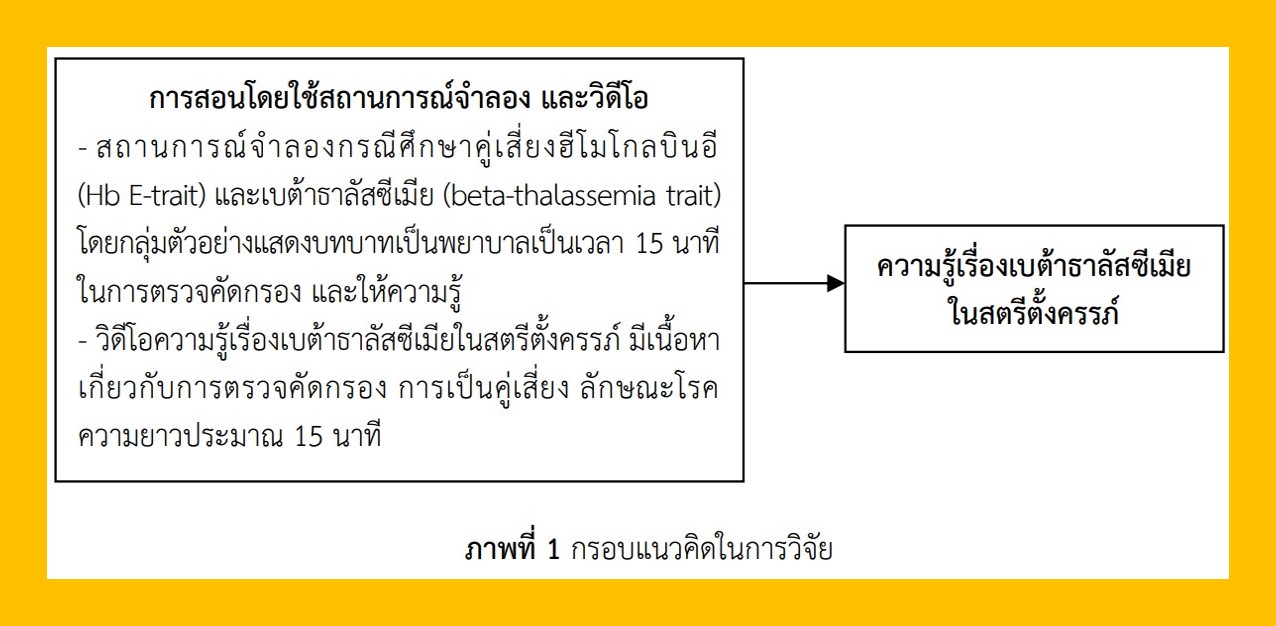ผลของการสอนโดยใช้สถานการณ์จำลองและวิดีโอต่อความรู้เรื่องเบต้าธาลัสซีเมียในสตรีตั้งครรภ์ของนักศึกษาพยาบาลชั้นปีที่ 3 มหาวิทยาลัยเกษมบัณฑิต
คำสำคัญ:
การสอน, สถานการณ์จำลอง, วิดีโอ, ความรู้เบต้าธาลัสซีเมีย, สตรีตั้งครรภ์บทคัดย่อ
การวิจัยในครั้งนี้เป็นการวิจัยกึ่งทดลองแบบหนึ่งกลุ่ม วัดผลก่อนและหลังนี้ มีวัตถุประสงค์เพื่อศึกษาผลของการสอนโดยใช้สถานการณ์จำลองและวิดีโอต่อความรู้เรื่องเบต้าธาลัสซีเมียในสตรีตั้งครรภ์ กลุ่มตัวอย่าง คือ นักศึกษาพยาบาลชั้นปีที่ 3 คณะพยาบาลศาสตร์ มหาวิทยาลัยเกษมบัณฑิต เลือกกลุ่มตัวอย่างแบบเจาะจง จำนวน 54 ราย เครื่องมือที่ใช้ในการดำเนินการวิจัย ประกอบด้วย สถานการณ์จำลอง และวิดีโอเรื่องเบต้าธาลัสซีเมียในสตรีตั้งครรภ์ เครื่องมือที่ใช้ในการเก็บรวบรวมข้อมูล ประกอบด้วย แบบบันทึกข้อมูลส่วนบุคคล และแบบทดสอบความรู้เรื่องเบต้าธาลัสซีเมีย ค่าดัชนีความตรงเชิงเนื้อหา เท่ากับ .86 และค่าความเชื่อมั่น เท่ากับ .80 วิเคราะห์ข้อมูลโดยใช้สถิติเชิงพรรณนา และสถิติทดสอบค่าที
ผลการวิจัย พบว่า หลังการสอนโดยใช้สถานการณ์จำลอง และวิดีโอเรื่องเบต้าธาลัสซีเมียในสตรีตั้งครรภ์ กลุ่มตัวอย่างมีคะแนนเฉลี่ยความรู้เรื่องเบต้าธาลัสซีเมียมากกว่าก่อนได้รับการสอน อย่างมีนัยสำคัญทางสถิติ (t = 20.283, p-value < .001) จากผลการวิจัยในครั้งนี้ แสดงให้เห็นถึงการสอนโดยใช้สถานการณ์จำลองร่วมกับวิดีโอ ตามหลักของแนวคิด Bloom’s Taxonomy ส่งผลให้นักศึกษาเกิดการเรียนรู้ มีความรู้ และสามารถนำวิธีการสอนนี้ไปประยุกต์ใช้ในเนื้อหาอื่น และรายวิชาอื่น ๆ ได้ ซึ่งสามารถนำไปสู่การปฏิบัติทางการพยาบาลได้อย่างมีประสิทธิภาพ
เอกสารอ้างอิง
Bureau of Medical Studies. Guidelines for the care of thalassemia patients in general practice. 1st ed. Buakhao J, editor. Nonthaburi: Printing Business Office War Veterans Organization under Royal Patronage; 2017. (in Thai)
Tana C, Vanaphirak C. Thalassemia in pregnant women [Internet]. 2017 [cited 2023 Nov 25]. Available from: https://w1.med.cmu.ac.th/obgyn/lecturestopics/topic-review/5679/ (in Thai)
Wongkham J, Ratanasiri T, Komwilaisak R, Saksiriwuttho P, Paibool M, Chatvised P. Thalassemia screening in pregnant women at antenatal care clinic Srinagarind hospital. Srinagarind Medical Journal 2013;28(2):170-7. (in Thai)
Maraphen R, Boonkoum W, Kheovichai K. Effect of a learning instructional by using standardized patients as simulation in home visits. Thai Red Cross Nursing Journal 2021;14(1):125-39. (in Thai)
Schiavenato M. Reevaluating simulation in nursing education: beyond the human patient simulator. Journal of Nursing Education 2009;48(7):388-94. doi: 10.3928/01484834-20090615-06.
Boonchuay N, Sanasuttipun W, Chintanadilok N, Sanpakit K. The effect of the educational program on knowledge and care behaviors of caregivers of children with thalassemia. Journal of Nursing Science 2016;34(3):41-53. (in Thai)
Alsaraireh A, Madhavanprabhakaran G, Raghavan D, Arulappan J, Khalaf A. Effect of a high-fidelity simulation-based teaching-learning experience (SBTLE) on maternal health nursing students’ knowledge of postpartum hemorrhage, confidence, and satisfaction. Teaching and Learning in Nursing [Internet]. 2023 [cited 2023 Nov 25]. Available from: https://doi.org/10.1016/j.teln.2023.10.009
Krathwohl DR. A revision of bloom’s taxonomy: an overview. Theory Into Practice 2002;41(4):212-8. doi: 10.1207/s15430421tip4104_2.
Abdulrahaman MD, Faruk N, Oloyede AA, Surajudeen-Bakinde NT, Olawoyin LA, Mejabi OV, et al. Multimedia tools in the teaching and learning processes: a systematic review. Heliyon 2020;6(11):e05312. doi: 10.1016/j.heliyon.2020.e05312.
Anderson HM. Dale’s cone of experience [Internet]. 1969 [cited 2023 Nov 10]. Available from: https://www.academia.edu/38517105/Dales_Cone_of_Experience_summary_pdf
Dale E. Audio-visual methods in teaching. 3rd ed. New York: Dryden Press; 1969.
Thede LQ, Sewell JP. Informatics and nursing: competencies and applications. 3rd ed. Philadelphia: Lippincott Williams and Wilkins; 2010.
Srisatidnarakul B. The methodology in nursing research. Bangkok: You and I intermedia; 2010. (in Thai)
Srisatidnarakul B. Effect size, power analysis, optimal sample size calculations, using G* power software. Bangkok: Chulalongkorn University Press; 2020. (in Thai)
Toqan D, Ayed A, Khalaf IA, Alsadi M. Effect of high-fidelity simulation on self-satisfaction and self-confidence among nursing students. SAGE Open Nursing 2023;9:1-8. doi: 10.1177/23779608231194403.
Hung CC, Kao HFS, Liu HC, Liang HF, Chu TP, Lee BO. Effects of simulation-based learning on nursing students’ perceived competence, self-efficacy, and learning satisfaction: a repeat measurement method. Nurse Education Today 2021;97:104725. doi: 10.1016/j.nedt.2020.104725.

ดาวน์โหลด
เผยแพร่แล้ว
รูปแบบการอ้างอิง
ฉบับ
ประเภทบทความ
สัญญาอนุญาต
ลิขสิทธิ์ (c) 2023 วารสารเกื้อการุณย์

อนุญาตภายใต้เงื่อนไข Creative Commons Attribution-NonCommercial-NoDerivatives 4.0 International License.














